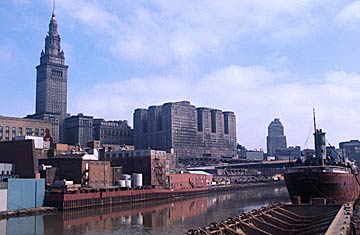
March 11, 1970: Views of the Cuyahoga River shown here, the river is a constant fire hazard because of quantities of oil deposited in it by numerous industries in the Cleveland area.
ALMOST every great city has a river. The poetic notion is that flowing water brings commerce, delights the eye, and cools the summer heat. But there is a more prosaic reason for the close affinity of cities and rivers. They serve as convenient, free sewers.
The Potomac reaches the nation's capital as a pleasant stream, and leaves it stinking from the 240 million gallons of wastes that are flushed into it daily. Among other horrors, while Omaha's meat packers fill the Missouri River with animal grease balls as big as oranges, St. Louis takes its drinking water from the muddy lower Missouri because the Mississippi is far filthier. Scores of U.S. rivers are severely polluted—the swift Chattahoochee, majestic Hudson and quiet Milwaukee, plus the Buffalo, Merrimack, Monongahela, Niagara, Delaware, Rouge, Escambia and Havasupi. Among the worst of them all is the 80-mile-long Cuyahoga, which splits Cleveland as it reaches the shores of Lake Erie.
No Visible Life. Some river! Chocolate-brown, oily, bubbling with subsurface gases, it oozes rather than flows. "Anyone who falls into the Cuyahoga does not drown," Cleveland's citizens joke grimly. "He decays." The Federal Water Pollution Control Administration dryly notes: "The lower Cuyahoga has no visible life, not even low forms such as leeches and sludge worms that usually thrive on wastes." It is also—literally —a fire hazard. A few weeks ago, the oil-slicked river burst into flames and burned with such intensity that two railroad bridges spanning it were nearly destroyed. "What a terrible reflection on our city," said Cleveland Mayor Carl Stokes sadly.
Cleveland's great industries have lately made efforts to dump fewer noxious effluents into the Cuyahoga. If their record is still not good, the city's has been far worse. Whenever it rains hard, the archaic sanitary storm system floods the sewer mains, sending untreated household wastes into the river. Sometimes the old mains break, as recently happened on the Big Creek interceptor line. Each day for the past month, 25 million gallons of raw sewage have cascaded from a ruptured pipe, spilling a gray-green torrent into the Cuyahoga and thence into Lake Erie.
Some lake! Industrial wastes from Detroit's auto companies, Toledo's steel mills and the paper plants of Erie, Pa., have helped turn Lake Erie into a gigantic cesspool. Of 62 beaches along its U.S. shores, only three are rated completely safe for swimming. Even wading is unpleasant; as many as 30,000 sludge worms carpet each square yard of lake bottom.
Each day, Detroit, Cleveland and 120 other municipalities fill Erie with 1.5 billion gallons of inadequately treated wastes, including nitrates and phosphates. These chemicals act as fertilizer for growths of algae that suck oxygen from the lower depths and rise to the surface as odoriferous green scum. Commercial and game fish—blue pike, whitefish, sturgeon, northern pike—have nearly vanished, yielding the waters to trash fish that need less oxygen. Weeds proliferate, turning water frontage into swamp. In short, Lake Erie is in danger of dying by suffocation.
Scrub the Water. What can be done? The Federal Government has outlined a $1.1 billion program for upgrading the sewage treatment plants of Lake
